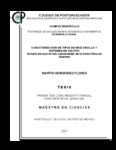| dc.contributor.author | Hernández Flores, Martín | es |
| dc.creator | HERNANDEZ FLORES, MARTIN | |
| dc.date.accessioned | 2012-09-09T22:56:37Z | |
| dc.date.available | 2012-09-09T22:56:37Z | |
| dc.date.issued | 2007 | es |
| dc.identifier.uri | http://hdl.handle.net/10521/1557 | |
| dc.description | Tesis (Maestría en Ciencias, especialista en Desarrollo Rural).- Colegio de Postgraduados, 2007. | es |
| dc.description.abstract | La investigación ha privilegiado la identificación y caracterización de un bien histórico de gran importancia patrimonial y valor presente, que se manifiesta como factor fundamental a través de un conjunto de poblaciones de maíces nativos -conocidos localmente como criollos-, al interior de una amplia diversidad y multifuncionalidad de sistemas productivos, en la región de la Costa Chica de Guerrero. La tendencia de la modernización de la agricultura durante los últimos años, demuestra que en la región se ha excluido sistemáticamente el valor presente de los recursos locales, los cuales indudablemente forman parte de las lógicas de funcionamiento de los sistemas de producción campesinos e indígenas. En particular, ha sido y es notorio el desinterés -siempre presente- por las poblaciones de maíces criollos, que se producen año tras año en recreación constante por los campesinos. Lo anterior, como resultado de las orientaciones modernizadoras de la agricultura de ayer y hoy. En la región de estudio, la existencia de una importante diversidad de maíces criollos es de interés fundamental, considerando su valor estratégico histórico y actual en la economía campesina con fines de satisfacción de sus necesidades alimenticias. Organizados por esta diversidad, se han desarrollado sistemas complejos que integran cultivos asociados principalmente con fines alimenticios; sin duda construidos históricamente como fundamento de una cultura sociotécnica y gastronómica tradicional. Por lo tanto, la investigación privilegió la identificación y caracterización de las poblaciones locales de maíces criollos. A partir de una diversidad territorial de 11 tipos de criollos fueron predominantes: Palmeño y Olotillo, entre los cuales el análisis y estudio comparativo de un sistema de variables tiende a evidenciar que son diferentes. Los programas oficiales promueven la utilización de híbridos y la modernización agroindustrial de los sistemas productivos locales. Así mismo, no contemplan ni integran la posibilidad de un rescate patrimonial y mejoramiento de los maíces criollos._____The investigation has privileged the identification and characterization of an historical good of great patrimonial importance and value present that is pronounced like fundamental factor through a set of native maize populations -.known locally like Creoles, to the interior of an ample diversity and multifunctional of productive systems, in the region of the Costa Chica of Guerrero. The tendency of the agriculture modernization in the last years, show that in the region the present value has been excluded systematically from the local resources, which doubtlessly comprise of the logics of operation of the production systems farmers and natives. In particular, it has been and he is well-known the disinterest - always present by the Creole maize populations, that its produced year by year in constant recreation by the farmers. The previous thing is the result from the actual directions of the agriculture of yesterday and today. In the study region the existence of an important Creole maize diversity is of fundamental interest, considering its historical strategic value actual in the economy farmer with aims of satisfaction of its nutritional necessities. Organized by this diversity, complex systems have been developed that integrate mainly associate cultures with nutritional aims; without a doubt constructed historically like foundation of traditional, social technical and gastronomical culture. Therefore, the investigation privileged the identification and characterization of the local Creole maize populations. From a diversity of 11 types of Creoles they were predominant: Palmeño and Olotillo, between which the analysis and comparative study of a system of variables tend to demonstrated that they are different. The official programs promote the use of hybrids and the agro-industrial modernization of the local productive systems. Also, they do not contemplate nor they integrate the possibility of a patrimonial rescue and improvement of Creoles maize. | es |
| dc.description.sponsorship | CONACYT | es |
| dc.language.iso | spa | es |
| dc.rights.uri | http://creativecommons.org/licenses/by-nc-nd/4.0 | |
| dc.subject | Tipos de maíz criollo | es |
| dc.subject | Sistemas de cultivo | es |
| dc.subject | Caracterización | es |
| dc.subject.ddc | Maestría | |
| dc.subject.ddc | Desarrollo Rural | |
| dc.title | Caracterización de tipos de maíz criollo y sistemas de cultivo : estudio de caso en tres comunidades de la Costa Chica de Guerrero | es |
| dc.type | Tesis | es |
| Tesis.contributor.advisor | Navarro Garza, Hermilio | es |
| Tesis.contributor.advisor | Pérez Olvera, Ma. Antonia | es |
| Tesis.contributor.advisor | Castillo González, Fernando. | es |
| Tesis.subject.nal | Maíz - Tecoanapa, Guerrero (México). | |
| Tesis.subject.nal | Cultivo - Tecoanapa, Guerrero (México). | |
| Tesis.subject.nal | Comunidades rurales - Tecoanapa, Guerrero (México). | |
| Tesis.subject.nal | Agricultura - Tecoanapa, Guerrero (México). | |
| Tesis.subject.nal | Siembra - Tecoanapa, Guerrero (México). | |
| dc.subject.ingles | Types of creole maize | es |
| dc.subject.ingles | Systems of culture | es |
| dc.subject.ingles | Characterization | es |
| dc.type.conacyt | masterThesis | |
| dc.identificator | 5 | |
| dc.contributor.director | NAVARRO GARZA, HERMILIO; 2661 | |


